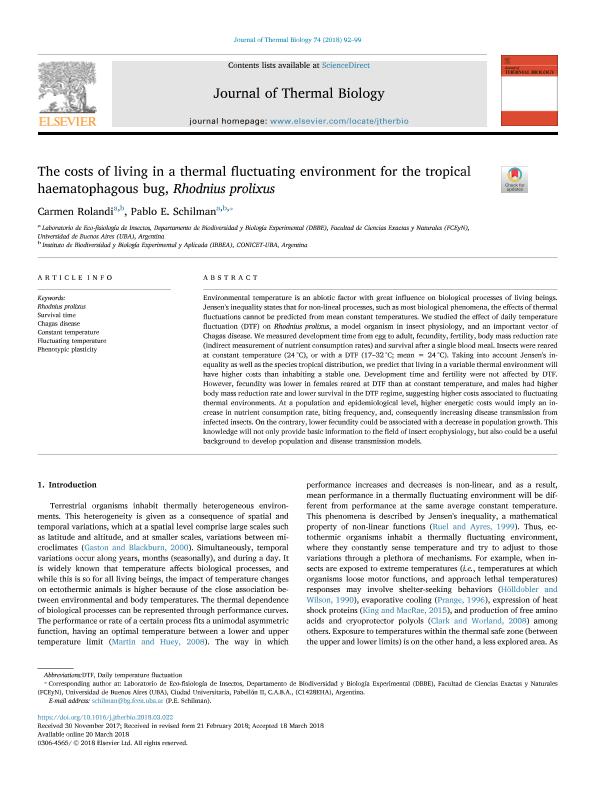Mostrar el registro sencillo del ítem
dc.contributor.author
Rolandi, Carmen

dc.contributor.author
Schilman, Pablo Ernesto

dc.date.available
2020-01-30T19:53:29Z
dc.date.issued
2018-05
dc.identifier.citation
Rolandi, Carmen; Schilman, Pablo Ernesto; The costs of living in a thermal fluctuating environment for the tropical haematophagous bug, Rhodnius prolixus; Pergamon-Elsevier Science Ltd; Journal of Thermal Biology; 74; 5-2018; 92-99
dc.identifier.issn
0306-4565
dc.identifier.uri
http://hdl.handle.net/11336/96274
dc.description.abstract
Environmental temperature is an abiotic factor with great influence on biological processes of living beings. Jensen's inequality states that for non-lineal processes, such as most biological phenomena, the effects of thermal fluctuations cannot be predicted from mean constant temperatures. We studied the effect of daily temperature fluctuation (DTF) on Rhodnius prolixus, a model organism in insect physiology, and an important vector of Chagas disease. We measured development time from egg to adult, fecundity, fertility, body mass reduction rate (indirect measurement of nutrient consumption rates) and survival after a single blood meal. Insects were reared at constant temperature (24 °C), or with a DTF (17–32 °C; mean = 24 °C). Taking into account Jensen's inequality as well as the species tropical distribution, we predict that living in a variable thermal environment will have higher costs than inhabiting a stable one. Development time and fertility were not affected by DTF. However, fecundity was lower in females reared at DTF than at constant temperature, and males had higher body mass reduction rate and lower survival in the DTF regime, suggesting higher costs associated to fluctuating thermal environments. At a population and epidemiological level, higher energetic costs would imply an increase in nutrient consumption rate, biting frequency, and, consequently increasing disease transmission from infected insects. On the contrary, lower fecundity could be associated with a decrease in population growth. This knowledge will not only provide basic information to the field of insect ecophysiology, but also could be a useful background to develop population and disease transmission models.
dc.format
application/pdf
dc.language.iso
eng
dc.publisher
Pergamon-Elsevier Science Ltd

dc.rights
info:eu-repo/semantics/openAccess
dc.rights.uri
https://creativecommons.org/licenses/by-nc-sa/2.5/ar/
dc.subject
CHAGAS DISEASE
dc.subject
CONSTANT TEMPERATURE
dc.subject
FLUCTUATING TEMPERATURE
dc.subject
PHENOTYPIC PLASTICITY
dc.subject
RHODNIUS PROLIXUS
dc.subject
SURVIVAL TIME
dc.subject.classification
Zoología, Ornitología, Entomología, Etología

dc.subject.classification
Ciencias Biológicas

dc.subject.classification
CIENCIAS NATURALES Y EXACTAS

dc.title
The costs of living in a thermal fluctuating environment for the tropical haematophagous bug, Rhodnius prolixus
dc.type
info:eu-repo/semantics/article
dc.type
info:ar-repo/semantics/artículo
dc.type
info:eu-repo/semantics/publishedVersion
dc.date.updated
2019-10-02T19:13:09Z
dc.journal.volume
74
dc.journal.pagination
92-99
dc.journal.pais
Estados Unidos

dc.description.fil
Fil: Rolandi, Carmen. Universidad de Buenos Aires. Facultad de Ciencias Exactas y Naturales. Departamento de Biodiversidad y Biología Experimental; Argentina. Consejo Nacional de Investigaciones Científicas y Técnicas. Oficina de Coordinación Administrativa Ciudad Universitaria. Instituto de Biodiversidad y Biología Experimental y Aplicada. Universidad de Buenos Aires. Facultad de Ciencias Exactas y Naturales. Instituto de Biodiversidad y Biología Experimental y Aplicada; Argentina
dc.description.fil
Fil: Schilman, Pablo Ernesto. Consejo Nacional de Investigaciones Científicas y Técnicas. Oficina de Coordinación Administrativa Ciudad Universitaria. Instituto de Biodiversidad y Biología Experimental y Aplicada. Universidad de Buenos Aires. Facultad de Ciencias Exactas y Naturales. Instituto de Biodiversidad y Biología Experimental y Aplicada; Argentina. Universidad de Buenos Aires. Facultad de Ciencias Exactas y Naturales. Departamento de Biodiversidad y Biología Experimental; Argentina
dc.journal.title
Journal of Thermal Biology

dc.relation.alternativeid
info:eu-repo/semantics/altIdentifier/url/https://www.sciencedirect.com/science/article/pii/S0306456517305107
dc.relation.alternativeid
info:eu-repo/semantics/altIdentifier/doi/https://doi.org/10.1016/j.jtherbio.2018.03.022
Archivos asociados
